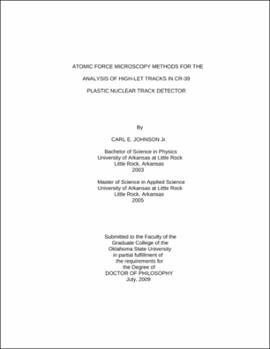| dc.contributor.advisor | Benton, Eric R. | |
| dc.contributor.author | Johnson, Carl E., Jr. | |
| dc.date.accessioned | 2013-11-26T08:26:34Z | |
| dc.date.available | 2013-11-26T08:26:34Z | |
| dc.date.issued | 2009-07 | |
| dc.identifier.uri | https://hdl.handle.net/11244/6899 | |
| dc.description.abstract | Scope and Method of Study: Proton- and neutron-induced target fragmentation reactions generate short-range (~1-10 µm), high-linear energy transfer (LET) heavy nuclear recoil (HNR) particles that contribute to total radiation dose deposited in healthy tissue in patients undergoing proton cancer therapy and to astronauts during spaceflight. Conventional detection using CR-39 plastic nuclear track detector (PNTD) that has been chemically etched for analysis by standard visible light microscopy fails because the required bulk etch, B ~ 40 µm removes short-range tracks. We have developed a method based on Atomic Force Microscopy (AFM) to directly measure HNR particle tracks in CR-39 PNTD. Novel algorithms using least squares ellipse fitting and estimation of fitting in an iterative process were developed to enable the analysis of nuclear tracks in AFM data. In irradiations conducted at the Loma Linda University Medical Center (LLUMC) Proton Therapy Facility and the NASA Space Radiation Laboratory (NSRL) at Brookhaven National Laboratory (BNL), targets of varying composition, including a number of elemental targets of high Z, were exposed in contact with layers of CR-39 PNTD to beams of 60 MeV, 230 MeV, and 1 GeV protons at doses between 2 and 10 Gy. Chemical etching of the CR-39 PNTD was performed under standard conditions (50°C, 6.25 N NaOH) for 2-4 hours (removed layer B = 0.5-1.0 µm). | |
| dc.description.abstract | Findings and Conclusions: The use of a short duration chemical etch yielded densities of secondary tracks of 105 -106 cm-2 using the analysis methods presented in this work for accelerator-based experiments. LET spectra were obtained with good statistics between 200 and 1500 keV/µm and the results were consistent with nonelastic nuclear cross sections. Absorbed dose measurements were also completed for selected detectors, ~7 x 10^-10 Gy ion-1 was measured for 230 MeV protons. Additionally our data are consistent with an isotropic HNR particle production mechanism. The semi-automated analysis method developed in this work has demonstrated the capability of analyzing detectors exposed to fluences of 10^8 cm^-2 for detectors exposed on spacecraft. This method should prove to be broadly applicable in future studies of HNR particles. | |
| dc.format | application/pdf | |
| dc.language | en_US | |
| dc.rights | Copyright is held by the author who has granted the Oklahoma State University Library the non-exclusive right to share this material in its institutional repository. Contact Digital Library Services at lib-dls@okstate.edu or 405-744-9161 for the permission policy on the use, reproduction or distribution of this material. | |
| dc.title | Atomic force microscopy methods for the analysis of high-let tracks in CR-39 plastic nuclear track detector | |
| dc.contributor.committeeMember | Arena, Andy S. | |
| dc.contributor.committeeMember | Yukihara, Eduardo | |
| dc.contributor.committeeMember | Rosenberger, Albert | |
| osu.filename | Johnson_okstate_0664D_10426.pdf | |
| osu.accesstype | Open Access | |
| dc.type.genre | Dissertation | |
| dc.type.material | Text | |
| thesis.degree.discipline | Physics | |
| thesis.degree.grantor | Oklahoma State University | |
